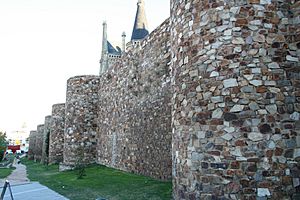Siege of Astorga facts for kids
The Siege of Astorga was an important battle during the Peninsular War in Spain. It happened in 1810 when French forces tried to capture the city of Astorga. This city was very important because of its location. It was on the side of the French army's path as they tried to invade Spain and Portugal. The French wanted to use Astorga as a main base for their operations.
For several weeks, not much fighting happened because neither side had enough powerful cannons, called artillery. But once the French cannons arrived, they quickly made a large hole in the city's walls. The French soldiers then attacked and took control of the city on April 20, 1810. They defeated the Spanish soldiers defending Astorga. The French lost about 160 men in this victory.
Quick facts for kids Siege of Astorga |
|||||||||
|---|---|---|---|---|---|---|---|---|---|
| Part of the Peninsular War | |||||||||
 The walls of Astorga |
|||||||||
|
|||||||||
| Belligerents | |||||||||
| Commanders and leaders | |||||||||
| Strength | |||||||||
| 27,000 | 2,800 | ||||||||
| Casualties and losses | |||||||||
| 800 | 2,800 | ||||||||
Contents
Why Astorga Was Important
Astorga is a city in northwest Spain, located in the province of León. Its position was very important during the Peninsular War. It sat on the side of the French army's route as they moved into Spain and then tried to invade Portugal.
The city was built on a hill, which was part of the Manzanal mountains. This natural location gave Astorga strong defenses. The French had actually tried and failed to capture Astorga once before, in September 1809. After that, a Spanish general named General La Romana made the city's walls even stronger and improved its defenses.
The Armies Involved
The French forces attacking Astorga were part of André Masséna's larger army. They were led by Jean-Andoche Junot. Junot arrived at Astorga on March 21, 1810, with about 12,000 soldiers, including 1,200 cavalry (soldiers on horseback).
Among Junot's troops was a group called the Irish Legion. This group had joined the French army earlier that month. The Siege of Astorga was the first battle for their Second Battalion.
The Battle Begins
Before Junot arrived, another French general, General Loison, had tried to take Astorga in February 1810. He wanted to use it as his main base for invading Portugal. However, he was not ready for the strong defenses he found and had to retreat.
When Junot's troops came to help Loison, they did not bring any special cannons for attacking city walls (called siege guns). It took Junot several weeks to gather enough artillery to attack Astorga. While they waited, the French soldiers dug trenches around the city to prepare for the siege.
Interestingly, when the English and Spanish armies later recaptured Astorga in 1812, they faced similar problems getting enough siege guns.
The Standoff
The Spanish soldiers defending Astorga also did not have any siege guns. So, for several weeks, there was a quiet period where neither side could launch a major attack. During this time, the Spanish commander, Santocildes, moved about 3,000 residents out of the city. He also made sure the city had plenty of supplies for the siege, which officially began on March 21, 1810.
The Spanish soldiers knew they could not expect help from Wellington's British and Spanish forces, who were still in Portugal. Until the French siege guns arrived, the only fighting was small attacks from the few cannons Junot had and quick raids by Spanish soldiers from Astorga.
The Walls Are Breached
Junot's 18 powerful siege guns finally arrived on April 15 from Valladolid. By April 20, these cannons had made a large hole, or "breach," in the city wall. The French soldiers prepared to storm the city the next evening.
Their first attack was very difficult. The Spanish defenders fought hard, and the French were pushed back, losing about 300 men. The French soldiers who survived the attack found shelter just inside the wall and held that position through the night.
The Surrender
The next morning, the French were getting ready for another attack. However, the Spanish commander, Santocildes, decided to surrender. He was almost out of ammunition, with fewer than 30 rounds per soldier and only 8 cannon rounds left.
Santocildes handed over the city and about 2,500 Spanish prisoners to the French. Even though the French won, the Spanish defense cost them 160 men killed and 400 wounded. The Spanish garrison had fewer losses, with only 51 dead and 109 wounded. Most of the French casualties happened during the difficult attack on the breach in the wall.
The Irish Legion led the charge over the wall and suffered many losses. There's a famous story about a drummer boy from Captain John Allen's company. He kept beating his drum to encourage the charge even after losing both his legs. For his bravery, he was given the French Legion of Honor.
See also
 In Spanish: Sitios de Astorga para niños
In Spanish: Sitios de Astorga para niños

